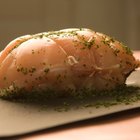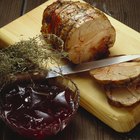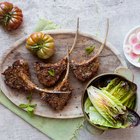
Microwave ovens don’t have much of a reputation for anything more than reheating last night’s mac and cheese -- and they’re definitely not touted as the way to go if you're undertaking something as temperamental as a tender lamb roast. But that changes when you know how to work around a microwave’s limitations. The biggest problem associated with cooking meat in a microwave is color. You’ll never get it brown because the moisture released during the microwaving prevents the temperature from going above the boiling point of water. However, you can cook the lamb in an oven bag – which distributes heat evenly throughout the meat – and pan sear it afterward, a technique commonly used to caramelize sous vide and poached foods in professional kitchens.
Step 1
Remove the lamb roast from the freezer, if frozen, and place it on a tray lined with a few paper towels. Thaw the lamb in the refrigerator for 24 hours for every 5 pounds.
Step 2
Unwrap the lamb, if it's wrapped in plastic, and pat it dry with paper towels. Let the lamb reach room temperature. Whether prepared in a conventional oven, on a grill or in a microwave, room-temperature meat cooks more evenly than cold meat. Place the lamb on a cutting board and coat it generously with a fat, such as olive oil.
Step 3
Season the lamb roast to taste using coarse salt, freshly ground black pepper and the spices and dried herbs of choice. Fresh herbs don’t hold up to microwave-oven cooking as well as dried herbs, but you can finish the lamb with fresh herbs after it's done cooking, if desired.
Step 4
Tie the lamb snugly, crosswise and at 1-inch intervals, with kitchen twine. Tying helps the meat keep its shape during cooking, which leads to even heating throughout – a must when microwaving a roast.
Step 5
Place the lamb in a large oven bag, followed by about 1/4 cup of liquid, such as marinade, stock or water, for every pound of meat. The combination of an oven bag and liquid takes cooking the lamb evenly in a microwave oven a step further, helping keep both the inside and out of the meat cooking in tandem.
Step 6
Add aromatic vegetables, such as garlic cloves, onions, carrots or celery, to the oven bag, if desired, and tie it with the supplied nylon tie. Place the oven bag of lamb on a microwave-safe rack set inside a baking dish.
Step 7
Insert a microwave-safe thermometer in the center of the lamb roast. Place the lamb in the microwave oven.
Step 8
Set the microwave oven to cook at 50 percent power. Set the timer to cook for nine to 11 minutes per pound. For example, if you have a 5-pound lamb roast, set the timer for 45 to 55 minutes.
Step 9
Start the microwave and allow it to cook until five minutes remain on the timer. Open the microwave, with your face and body pointing away from it, and wait a minute for the steam to clear enough to read the thermometer.
Step 10
Check the temperature on the thermometer. A 140-degree Fahrenheit temperature indicates rare doneness, 150 to 155 degrees F indicates medium doneness, and anything at 160 degrees F and above indicates that the meat is well-done. If you want to pan sear the lamb after microwaving it, cook it just under the desired level of doneness. For example, if you want a medium roast, but also want a caramelized crust on the outside, cook it to medium rare in the microwave. The pan sear will raise the doneness to medium.
Step 11
Remove the lamb from the microwave when it reaches the desired internal temperature, using oven mitts to protect your hands. Allow a few minutes for the bag to deflate, indicating the steam dissipated.
Step 12
Remove the lamb from the bag and place it on a plate. Reserve the liquid and aromatic vegetables for sauce, if desired.
Step 13
Coat a large skillet with a fat, such as olive oil, and place it on the stove over high heat for about three minutes. Place the lamb in the skillet and sear it on all sides until caramelized, using tongs to turn it.
Step 14
Remove the lamb from the skillet and place it on cooling rack. Let the lamb rest for five minutes for every pound before untying it and serving.
Related Articles

How to Cook a Roast in a Bag

How to Braise Pork

How to Cook a Beef Topside Roast

How to Cook a Bone-in Leg of Lamb
How to Slow Cook a Pot Roast With Beef ...

How to Cook Veal Sirloin

Food Safety Tips for Frozen Pork

Toaster Oven Cooking Times

How to Cook a Beef Roast in a Roaster ...

How to Microwave Top-Round Roast Beef

Baking Pork Tenderloin, Potatoes & ...

How to Cook a Moist & Tender Center Cut ...

How to Make Pot Roast in a Cooking Bag
The Best Way to Cook Four Pounds of ...

How to Cook Chicken Curry Using a ...

Slow Cooking a Roast in a French Oven

How to Cook a Rolled Beef Chuck Roast ...

How to Cook Boneless Beef Chuck Medium ...

How to Grill Rack of Lamb

What Can You Do With London Broil Steak?
References
Writer Bio
A.J. Andrews' work has appeared in Food and Wine, Fricote and "BBC Good Food." He lives in Europe where he bakes with wild yeast, milks goats for cheese and prepares for the Court of Master Sommeliers level II exam. Andrews received formal training at Le Cordon Bleu.
Photo Credits
Eising/Photodisc/Getty Images